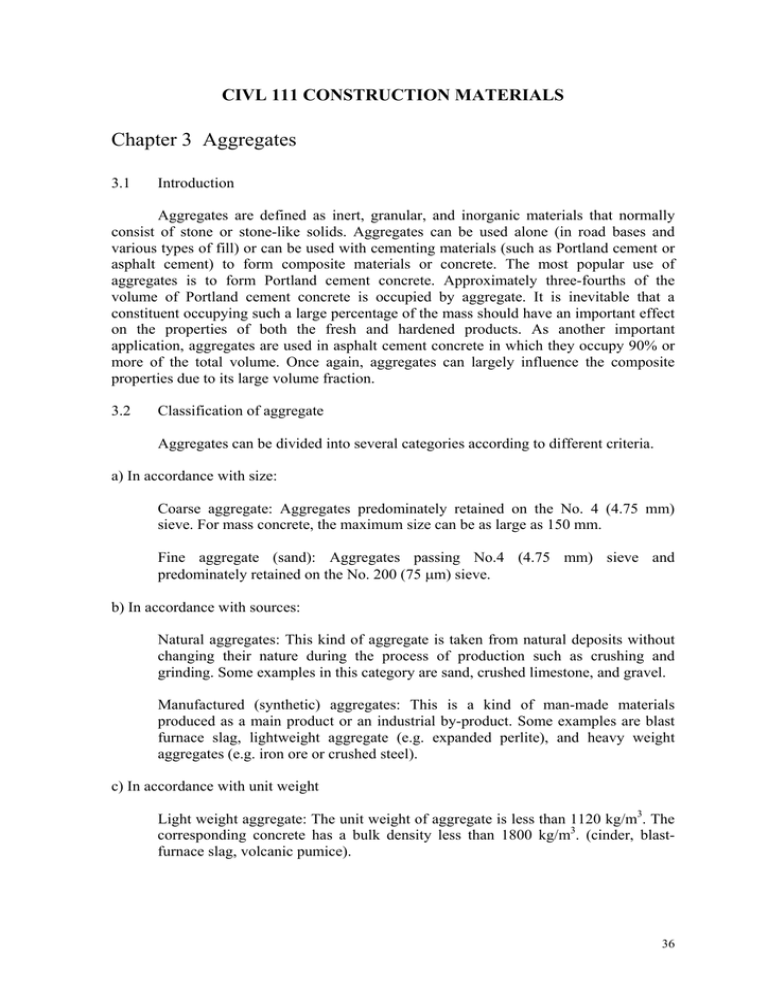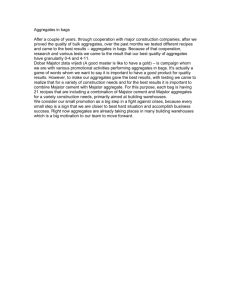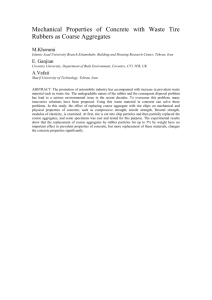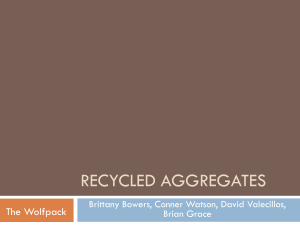Chapter 3 Aggregates CIVL 111 CONSTRUCTION MATERIALS
advertisement

CIVL 111 CONSTRUCTION MATERIALS Chapter 3 Aggregates 3.1 Introduction Aggregates are defined as inert, granular, and inorganic materials that normally consist of stone or stone-like solids. Aggregates can be used alone (in road bases and various types of fill) or can be used with cementing materials (such as Portland cement or asphalt cement) to form composite materials or concrete. The most popular use of aggregates is to form Portland cement concrete. Approximately three-fourths of the volume of Portland cement concrete is occupied by aggregate. It is inevitable that a constituent occupying such a large percentage of the mass should have an important effect on the properties of both the fresh and hardened products. As another important application, aggregates are used in asphalt cement concrete in which they occupy 90% or more of the total volume. Once again, aggregates can largely influence the composite properties due to its large volume fraction. 3.2 Classification of aggregate Aggregates can be divided into several categories according to different criteria. a) In accordance with size: Coarse aggregate: Aggregates predominately retained on the No. 4 (4.75 mm) sieve. For mass concrete, the maximum size can be as large as 150 mm. Fine aggregate (sand): Aggregates passing No.4 (4.75 mm) sieve and predominately retained on the No. 200 (75 μm) sieve. b) In accordance with sources: Natural aggregates: This kind of aggregate is taken from natural deposits without changing their nature during the process of production such as crushing and grinding. Some examples in this category are sand, crushed limestone, and gravel. Manufactured (synthetic) aggregates: This is a kind of man-made materials produced as a main product or an industrial by-product. Some examples are blast furnace slag, lightweight aggregate (e.g. expanded perlite), and heavy weight aggregates (e.g. iron ore or crushed steel). c) In accordance with unit weight Light weight aggregate: The unit weight of aggregate is less than 1120 kg/m3. The corresponding concrete has a bulk density less than 1800 kg/m3. (cinder, blastfurnace slag, volcanic pumice). 36 Normal weight aggregate: The aggregate has unit weight of 1520-1680 kg/m3. The concrete made with this type of aggregate has a bulk density of 2300-2400 kg/m3. Heavy weight aggregate: The unit weight is greater than 2100 kg/m3. The bulk density of the corresponding concrete is greater than 3200 kg/m3. A typical example is magnesite limonite, a heavy iron ore. Heavy weight concrete is used in special structures such as radiation shields. 3.3 Properties of aggregate 3.3.1 Moisture conditions The moisture condition of aggregates refers to the presence of water in the pores and on the surface of aggregates. There are four different moisture conditions: a) Oven Dry (OD): This condition is obtained by keeping aggregates at temperature of 1100C for a period of time long enough to reach a constant weight. b) Air Dry (AD): This condition is obtained by keeping aggregates under room temperature and humidity. Pores inside the aggregate are partly filled with water. c) Saturated Surface Dry (SSD): In this situation the pores of the aggregate are fully filled with water and the surface is dry. This condition can be obtained by immersion in water for 24 hours following by drying of the surface with wet cloth. d) Wet (W): The pores of the aggregate are fully filled with water and the surface of aggregate is covered with a film of water. Oven Dry OD Air Dry AD Saturated Surface Dry SSD Wet 37 3.3.2 Moisture content (MC) calculations a) Relative to oven dry condition MC ( OD ) = Wstock − WOD 100% WOD where Wstock = weight of aggregates in stock WOD = weight of oven dry aggregates b) Relative to saturated surface dry condition MC ( SSD ) = Wstock − WSSD 100% WSSD where Wstock = weight of aggregates in stock WSSD = weight of aggregates in SSD condition c) Absorption capacity Absorption = WSSD − WOD 100% WOD To make concrete, aggregates are mixed with water and cement. Since concrete properties at both the fresh and hardened states are strongly affected by the water content, it is very important to ensure that the right amount of water is added to the mix. In designing concrete mix, the moisture content under SSD condition is used as reference because that is an equilibrium condition at which the aggregates will neither absorb water nor give up water to the paste. Thus, if MCSSD value for a batch of aggregates is positive, there is surface moisture on the aggregates. If it is negative, it means that the pores in aggregates are only partly filled with water. Since the aggregates may give out or absorb water, the amount of water added to the mix need to be adjusted according to the MCSSD value. This is particularly important for concrete with low water content as the amount of adjusted water can be a significant portion of the total amount. 3.3.3 Density and specific gravity Definitions Density (D): weight per unit volume (excluding the pores inside a single aggregate) D= weight Vsolid Bulk density: the volume includes the pores inside a single aggregate. 38 weight Vsolid + V pores BD can be either BDSSD or BDAD according to the moisture condition of aggregate when it is weighed. BD = Specific gravity (SG): mass of a given substance divided by unit mass of an equal volume of water (it is the density ratio of a substance to water). Depending on the definition of volume, the specific gravity can be divided into absolute specific gravity (ASG) and bulk specific gravity(BSG). weight of particle Vsolid D ASG = = density of water ρw and BSG = weight of particle Vsolid + V pores density of water = BD ρw In practice, the BSG value is the realistic one to use since the effective volume that aggregate occupies in concrete includes its internal pores. The BSG of most rocks is in the range of 2.5 to 2.8. Similar to BD, BSG can be either BSGSSD or BSGAD according to the moisture condition of aggregates. The BSG can be determined using the displacement method. In this method, Archimedes’ principle is utilized. The weight of aggregate is first measured in air, e.g. under SSD condition, this is denoted as WSSD in air. Then, the weight of the sample is measured in water, the value being denoted as WSSD in water. Thus, we have: BSGSSD = = WSSD in air Wdisplacement WSSD in air WSSD in air - WSSD in water Where, Wdisplacement is the weight of water displaced by the aggregates. 39 3.3.4 Unit Weight (UW) (except for pores inside every aggregate, the bulk volume includes the spacing among aggregate particles). The unit weight is defined as weight per unit bulk volume for bulk aggregates. Besides the pores inside each aggregate, the bulk volume also includes the space among the collection of particles. According to the weight measured at different conditions, the unit weight can be divided into UW (SSD) and UW (OD). Vsolid WSSD + V pores + Vspacing Vsolid WOD + V pores + Vspacing UW ( SSD ) = and UW ( OD ) = The percentage of spacing (voids) among the aggregates can be calculated as Spacing ( void ) = 3.4 BD − UW 100% BD Grading of aggregates 3.4.1 Grading - size distribution The particle size distribution of aggregates is called grading. The grading determine the paste requirement for a workable concrete since the amount of void requires needs to be filled by the same amount of cement paste in a concrete mixture. To obtain a grading curve for aggregate, sieve analysis has to be conducted. The commonly used sieve designation is as follows: Sieve designation 3" 1.5" 3/4" 3/8" No. 4 No. 8 No. 16 No.30 No.50 No.100 No.200 Nominal size of sieve opening 75 mm 37.5 mm 19 mm 9.5 mm 4.75 mm 2.36 mm 1.18 mm 600 μm 300 μm 150 μm 75 μm 40 Five different kinds of size distributions, dense graded, gap-graded, uniformly graded, well graded and open graded are illustrated in the figure below. Dense and wellgraded aggregates are desirable for making concrete, as the space between larger particles is effectively filled by smaller particles to produce a well-packed structure. Gap-grading is a kind of grading which lacks one or more intermediate size. Gap-graded aggregates can make good concrete when the required workability is relatively low. When they are used in high workability mixes, segregation may become a problem. For the uniform grading, only a few sizes dominate the bulk material. With this grading, the aggregates are not effectively packed, and the resulting concrete will be more porous, unless a lot of paste is employed. The open graded contains too much small particles and easy to be disturbed by a hole. A wide range of grading curves is acceptable for the economic production of concrete with good quality. Both British Standards (B.S.) and American Standards of Testing and Measurements (ASTM) provide grading limits (which are essentially upper and lower bounds of the grading curve) that can be used in practice. As long as the grading curve lies within the recommended grading limits, the aggregate can be employed. 41 3.4.2 Fineness modulus To characterize the overall coarseness or fineness of an aggregate, a concept of fineness modulus is developed. The Fineness Modulus is defined as Fineness modulus = ∑ (Cummulative retained percentage) 100 To calculate the fineness modulus, the sum of the cumulative percentages retained on a definitely specified set of sieves needs to be determined, and the result is then divided by 100. The sieves specified for the determination of fineness modulus are No. 100, No. 50, No. 30, No. 16, No. 8, No. 4, 3/8", 3/4", 1.5", 3", and 6". The following table provide an example for calculating the fineness modulus. Table 3-1 Sieve analysis of aggregate The Fineness Modulus for fine aggregates should lie between 2.3 and 3.1. A small number indicates a fine grading; whereas a large number indicates a coarse material. The fineness modulus can be used to check the constancy of grading when relatively small change is expected; but it should not be used to compare the grading of aggregates from two different sources. The fineness modulus of fine aggregates is required for mix proportion since sand gradation has the largest effect on workability. A fine sand (low fineness modulus) needs more water for good workability. ASTM specifies that the variation of fineness modulus for different batches of a given mix should not exceed 0.2. 3.4.3 Fineness modulus for blending of aggregates Blending of aggregates is undertaken for a variety of purposes, for instance, to remedy deficiencies in grading. The fineness modulus of blended aggregates can be calculated if the values for the component aggregates are known. If two aggregates, 42 designated as A and B, with fineness moduli of FMA and FMB, respectively, are mixed, the resultant blend will have the following fineness modulus: PA P + FM B B 100 100 where, PA and PB are the percentages, by weight, of aggregate A and B in the blend. FM blend = FM A 3.5 Shape and texture of aggregate Aggregate shape and surface texture influence the properties of freshly mixed concrete more than the properties of hardened concrete. Rough-textured, angular, and elongated particles require more water to produce workable concrete than smooth, rounded compact aggregate. Consequently, the cement content must also be increased to maintain the watercement ratio. However, with rough aggregates, there is better mechanical bond in the hardened concrete, so strength is higher (if concrete with the same w/c ratio is compared). Hence, when smooth aggregates are replaced with rough aggregates, concrete of similar flow properties and strength can be produced by adding a little bit more water. In the following figure, both rounded (the first row) and angular (second row) aggregates are shown. The surface/volume ratio of spherical aggregates is the smallest. Nearspherical aggregates need less water for mixing and are desirable. Flat, needle-shaped and elongated particles should be avoided, as they require more water and are prone to segregation. When used in concrete, these aggregates can also lead to high stress concentrations and hence a reduction in strength. Generally, flat and elongated particles should be limited to about 15 percent by weight of the total aggregate. 43




